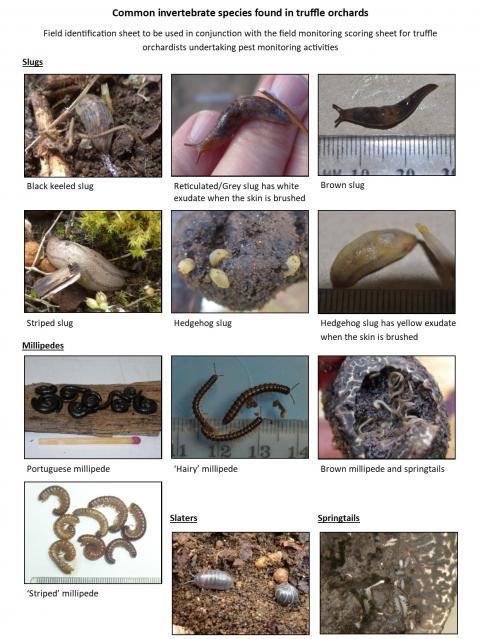DIY orchard pest monitoring
The best way for you to gain an understanding of the type and number of pests in your truffle orchard is to conduct regular monitoring and with information we have placed on the DPIRD website, you have the wherewithal to do this yourself. Our monitoring has shown that pest type, abundance, distribution and seasonality varies from orchard to orchard. By doing your own monitoring you can gain an understanding of what pests may be important and whether control strategies are needed. If so, they can be more targeted to those pests. Monitoring over time also allows you to see any impact of control methods used, while monitoring across the orchards can help identify ‘hot spots’.
Slugs and slaters are the most wide spread and abundant invertebrate pests and they can be monitored easily with simple equipment. You can choose to only record the number of slugs and slaters found or use the more detailed score sheet to record other pests such as millipedes, springtails and earwigs as well as predatory beetles. An Invertebrate field guide is available to help with identification.
What you will need for monitoring and the method are outlined below.
You will need
- Fifty, 20 cm square bathroom tiles. Large orchards would require more tiles to ensure good coverage and to see whether ‘hot spots’ occur.
- Flaky bran (available from a feed merchant or hardware store) and teaspoon.
- Score sheet, use either the slug and slater score sheet or the more detailed version.
- Invertebrate field guide
Method
- Plan the location of tiles so they are evenly spaced across the orchard.
- Place tiles close to a tree – this is where we find slugs and slaters will occur; they are out of the way of orchard operations; and more easily relocated.
- Before placing each tile, clear the ground the tile will sit on to remove leaves, weeds and small pebbles. This makes observing and counting easier.
- Place one heaped teaspoon of flaky bran on the ground and place the tile on top.
- Two days later check under each tile. Record the numbers of invertebrates present.
- We recommend removing bran after monitoring so that slugs and slaters can redistribute as normal so as not to bias future monitoring.
- Lean tile up against the tree until monitoring is repeated.
Repeat monitoring every four weeks or as time permits
For very abundant unidentified fauna, use the MyPest Guide Reporter app, or collect samples and contact one of the DPIRD truffle project team. If you send photos in for identification please ensure they are in focus and close enough to discern features.
This information on pest monitoring, plus links to score sheets and field guide pdf’s and project member contact details are available on the DPIRD website.

